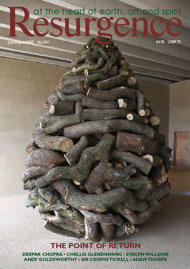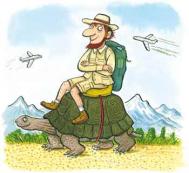RODDY FINNEGAN NOW lives in Kathmandu. In the early Sixties, Ireland felt too small for him, and at the age of eighteen he left first for London, then Ibiza (“a bit crowded even in ’64”), Africa and Asia. He travelled everywhere by bus, lorry or ship, taking his time along the way, reaching his destination step by step. In his terraced garden in the shadow of the Himalayas he told me, “I get these incandescent visions of all the things I’ve seen in my life: the Serengeti plain, the dhows on the Malabar coast, the innocence of Nepal. Back then travel was an adventure. We’d see a new city from the back of a truck. We’d see the lights. We’d think, ‘Behind one of those lights is a little room, and a bed.’ We were dropped off. We trusted in fate. We were blowing in the wind. Now a big jumbo jet dumps you at the corner.”
After the Napoleonic Wars, Grand Tourists, for the most part young and wealthy Romantics inspired by Byron and Shelley, began to travel in their numbers to Rome and Greece. On horseback and by bone-rattling carriage, their experiences established the concept of travel as a means of broadening one’s outlook, as well as an adventure of the Self. One hundred and fifty years later their successors, independent Sixties’ travellers like Finnegan, were motivated by Kerouac and Ginsberg to push further east, replacing the imaginative potency of Italy with that of India, making Asia the new touchstone of the exotic. Like the Grand Tourists before them, they travelled to be transformed by the foreign.
But with every hitchhike ride these travellers made, the world became a smaller place. The more young people who hit the road, the fewer roads remained unmarked by their passing. Jet aircraft doubled travel speed and halved journey time. Guide-books revealed secret tracks into hidden Thai valleys. Forgotten Indian palaces and Moroccan riads were transformed into backpackers’ hostels. Tourist ghettos rose above destinations as far apart as Marrakech and Goa, often overshadowing the host culture.
THREE YEARS AGO, I made a five-month journey from Istanbul to India along the Asia Overland ‘hippie’ trail. Travelling by bus and train, I hoped to discover why that route had captured the imagination of a generation, and how it had come to transform the way we travel the world today. As well as listening to Turks, Kurds, Iranians and Afghans, I observed Western travellers along the way. In Cappadocia, where hippies once dreamed of the dawning of a new age, everyone was sending text messages home. In Isfahan, former Persian capital and the most splendidly proportioned city in the world, every second tourist planned to write a travel article after their holiday. In the shattered remains of the Kabul Museum, I found an overworked guide-book writer. Most revealing of all, virtually every one of the global nomads I met had reached their destination by air.
The commercial dimension of tourism can’t be disputed. Worldwide the travel industry churns over US$500 billion and employs 195 million people. The personal benefit to travellers – the broadening of one’s outlook – is also irrefutable. A big journey can change lives, opening an individual’s eyes, galvanising the world’s cultures and fashions in the exchange and fusion of ideas. But the sheer number of relatively affluent globe-trotters – and I include myself – has already done enormous damage to the planet. Like a fast-mutating virus, we travellers are poisoning both the atmosphere and local tradition. Our hosts are continually expected to accommodate us, to submit to our demands and to surrender their resources, irrespective of the cost.
There is an urgent need to rethink leisure travel. Increasing numbers of enlightened tourists, and some companies, now realise that the benefits of the world’s largest industry must be shared more equitably. We are waking up to the environmental and social consequences of cheap air fares, especially the mainstream ‘mini-break’. Business travellers too have started to question the necessity of a physical journey in the information age. US corporations such as Cisco and IBM already arrange virtual meetings for far-flung executives on the social network website Second Life. The aviation industry will eventually be forced to take responsibility for its carbon emissions. But more must be done, and soon.
We have much to learn from Sixties’ travellers, even if we can’t afford to take two years to trek to India. Like them, we need to favour ground travel, to limit our flights, to stay longer in a single spot rather than dart between scattered destinations. We should reign in our gluttony for distance and take no more than a single, annual long-haul trip. A personal commitment to embrace Satish Kumar’s proposal to restore Sunday as a day for contemplation and Gaia, free from fossil fuels and flying, would reduce individual carbon emissions by at least one seventh (more, if madly wasteful weekend-away flights are eliminated). Above all we need to learn to move away from our culture of immediate gratification and choose trips where we can value the journey as much as the destination. Getting there should again become part of the adventure, galvanising us to live in the moment or – in the Sixties’ imperative – to Be Here Now.
BACK IN HIS terraced Nepalese garden, Finnegan continued to reminisce about earlier days. “I’ll tell you a story. In the Sixties no-one ever spent winters in Kathmandu. Everyone took the train south to Goa to catch some rays,” he said. “The first year we sat together in a circle on the beach playing guitars. The second year some new guy brought a cassette deck and rigged it up to a car battery. The third year another guy came with bigger speakers, then with amplifiers. In the fifth year a stage was set up and some kid asked me for my back-stage pass. My back-stage pass! What happened to our sacred beach, man? It was time to move on.”
But even by then there were few undiscovered places left for him to find. Travellers began to ask in a tone of rising panic, “Where to now, man? Where to now?” Over the course of a generation, Goa’s full-moon beach parties morphed from guitar-picking singsongs and psychedelic happenings to the Goa Trance scene. Ravers flew in for a week and took over the northern shore. Local Indians found themselves unwelcome in the waterside cafés.
A ring of hazy mountains was visible through the leaden veil of polluted air. “Kathmandu is now full of people reading the Lonely Planet guide to Vietnam!” said Finnegan, his voice filled with emotion.
Today’s ‘trailblazers’ – the ones reaching for the new frontier – are the ones who appreciate their power and travel in a manner that respects – even benefits – local communities, and that limits environmental impact. This attitude need not contract horizons: we can continue to be transformed by the foreign. In our discovered and fragile world, travel can still be an adventure.








